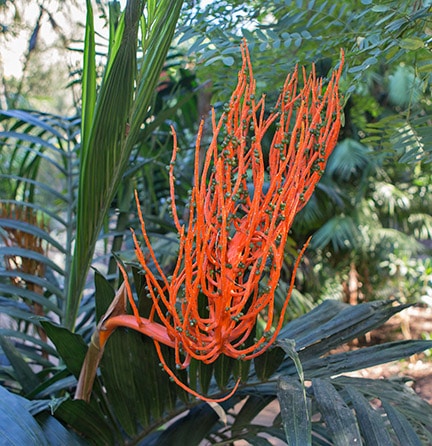Shade Palm Garden
Of the approximately 100 species of Chamaedorea palms, Lotusland’s collection in the Shade Palm Garden holds about 40
Shade Palm Garden
Of the approximately 100 species of Chamaedorea palms, Lotusland’s collection in the Shade Palm Garden holds about 40. These palms came from the collection of Don Hodel, palm expert and author of Chamaedorea Palms, The Species and Their Cultivation. These slender palms grow in the rain and cloud forests of Mexico, Central and South America, and most are small in stature. They can be stemless to 15 feet tall, although one species, C. elatior is more vine-like, clambering through vegetation for 60 feet or more. Plants of Chamaedorea are dioecious, meaning they have either male or female flowers on separate plants. These diminutive flowers are often fragrant and the inflorescence itself can be quite colorful with shades of yellow, orange, or red.
the
Noteworthy
Features
Leaf Shape
The leaf shape among this genus is quite diverse with many having pinnate (feather-like) leaves while others may be undivided or with a notched apex. These palms like consistent moisture and are great in low-light situations, being found naturally as understory plants in their forest habitats. One in particular, Chamaedorea elegans, the parlor palm, is a very common houseplant.
Notable Species
Chamaedorea ernesti-augusti (solitary), C. microspadix (clumping), Tipuana tipu (tipu tree)
Concretions
Concretions are a mudstone, often formed in nearshore oceans or lakes where mud settles out and compacts. Over geologic time the mudstone is heated and compacted and often has random layers of calcium carbonate within that helps to cement the layers together and make them less susceptible to erosion. Madame Ganna Walska purchased the concretions from a collector in Southern California. They were originally painted as folk art figures, and as they have weathered the paint has disappeared.


